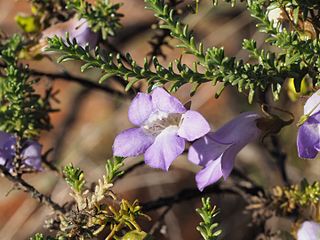
Eremophila bowmanii, also known as silver turkeybush, Bowman's poverty bush and flannel bush, is a flowering plant in the figwort family, Scrophulariaceae and is endemic to New South Wales and Queensland in Australia. It is a low to medium, spreading shrub with silvery-grey, hairy foliage and blue to lilac flowers, and sometimes grows in dense thickets with mulga.
Eremophila eriocalyx, commonly known as desert pride, is a flowering plant in the figwort family, Scrophulariaceae and is endemic to Western Australia. It is an erect shrub with greyish leaves, very hairy sepals and petals that range in colour from white to yellow, sometimes pink or purple.

Eremophila denticulata, also known as toothed eremophila, toothed poverty bush and Fitzgerald eremophila, is a flowering plant in the figwort family, Scrophulariaceae and is endemic to the south-west of Western Australia. It is an erect shrub with red flowers and leaves that have toothed margins.

Eremophila dichroantha, also known as bale-hook eremophila, is a flowering plant in the figwort family, Scrophulariaceae and is endemic to the south-west of Western Australia. It is a shrub with many ascending branches making the plant appear broom-like. It has small, hooked leaves and small, though abundant, violet to lilac-coloured flowers.

Eremophila clarkei, commonly known as turpentine bush, is a flowering plant in the figwort family, Scrophulariaceae and is endemic to Western Australia, South Australia and the Northern Territory. It is a shrub which is variable in form, but usually with narrow leaves and white or pale pink flowers. It is similar to Eremophila georgei and Eremophila granitica.

Eremophila fraseri, commonly known as burra or jilarnu, is a flowering plant in the figwort family, Scrophulariaceae and is endemic to Western Australia. It is a shrub or small tree with all above-ground parts of the plant, apart from the petals, sticky and shiny due to the presence of a large amount of resin. The petals are coloured white, cream, pink and brown.

Eremophila strongylophylla is a flowering plant in the figwort family, Scrophulariaceae and is endemic to Western Australia. It is a small shrub with distinctive round leaves, yellowish new growth and purple flowers which are white inside. It is similar to Eremophila mackinlayi and Eremophila hygrophana but distinguished from them by characteristics including leaf shape, and the type of hairs on its leaves and branches.

Eremophila weldii is a flowering plant in the figwort family, Scrophulariaceae and is endemic to Australia. It is a shrub with glabrous green leaves, small sepals and purple or lilac-coloured petals and it occurs in arid and semi-arid areas of Western Australia and South Australia.

Eremophila hughesii is a flowering plant in the figwort family, Scrophulariaceae and is endemic to Australia. It is spindly, glabrous shrub with narrow leaves and with flowers that vary in colour from blue to pink, sometimes white. It is native to Western Australia and the Northern Territory.
Glycocystis beckeri is the only species of the flowering plant genus Glycocystis in the family Scrophulariaceae and is endemic to the south west of Western Australia. It is a shrub, similar to others in the genera Eremophila and Myoporum but is unusual in that it produces very large amounts of sticky, sweet-smelling resin produced by raised glands which cover the entire plant, except for the petals. It has been suggested that the resin traps insects which the plant uses as a source of nitrogen.

Eremophila chamaephila, commonly known as earth-loving poverty bush is a flowering plant in the figwort family, Scrophulariaceae and is endemic to the south-west of Western Australia. It is a low, dense, spreading shrub with small, fleshy leaves and mauve to purple flowers.

Eremophila dempsteri is a flowering plant in the figwort family, Scrophulariaceae and is endemic to the south of Western Australia. It is an erect shrub with many upright stems, short, hooked leaves and pinkish-purple to white flowers with distinctive woolly sepals.

Eremophila densifolia is a flowering plant in the figwort family, Scrophulariaceae and is endemic to the south-west of Western Australia. It is usually a low, spreading shrub with densely clustered leaves and lilac to purple flowers.

Eremophila drummondii, commonly known as Drummond's eremophila, is a flowering plant in the figwort family, Scrophulariaceae and is endemic to the south-west of Western Australia. It is a variable shrub, usually with sticky branches and leaves, long, thin leaves and mauve or purple flowers in spring.

Eremophila exilifolia is a flowering plant in the figwort family, Scrophulariaceae and is endemic to Western Australia. It is a widely distributed shrub which is shaped like an inverted cone and has small, very sticky leaves and branches and lilac-coloured flowers.

Eremophila gibsonii is a flowering plant in the figwort family, Scrophulariaceae and is endemic to Australia. It is a sticky, glabrous, rounded shrub with narrow leaves and white to lilac-coloured flowers and which occurs in Western Australia, South Australia and the Northern Territory.

Eremophila ionantha is a flowering plant in the figwort family, Scrophulariaceae and is endemic to Western Australia. It is a shrub with many sticky branches, narrow, light green leaves and blue, purple or violet flowers.

Eremophila platythamnos, commonly known as desert foxglove, is a flowering plant in the figwort family, Scrophulariaceae and is endemic to Australia. It is an erect shrub with short, broad leaves and purple, mauve, blue or pink flowers.

Eremophila willsii is a flowering plant in the figwort family, Scrophulariaceae and is endemic to Australia. It is an erect shrub with bright green, often serrated leaves and pinkish to deep pinkish-purple petals. It is mainly found in Western Australia, the Northern Territory and South Australia in deep sand.

Pityrodia chrysocalyx is a flowering plant in the mint family Lamiaceae and is endemic to the south-west of Western Australia. It is an erect, bushy shrub with small, glossy leaves, and flowers with white petals and a golden-yellow calyx.



















